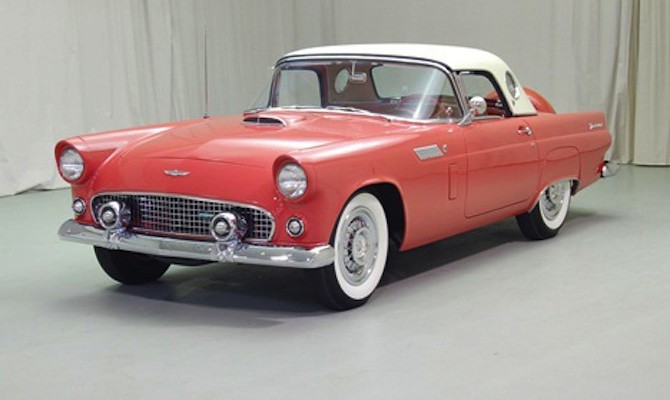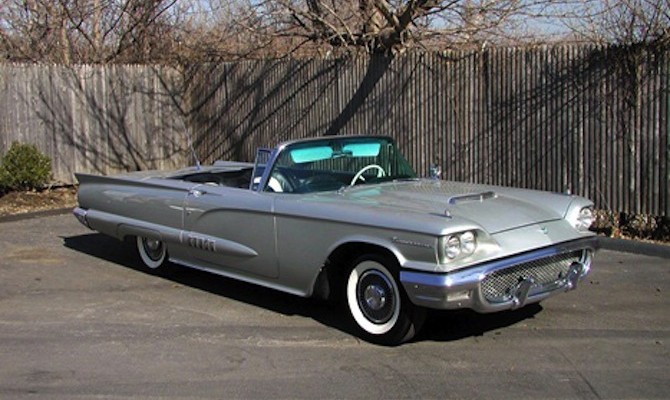“Low mileage first generation Miatas amazingly still trade for under 10 grand in its 25th year; it’s doubtful those prices will hold steady for its 50th.”
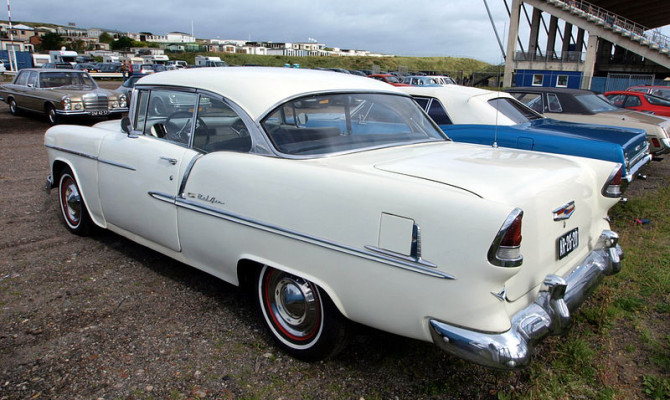
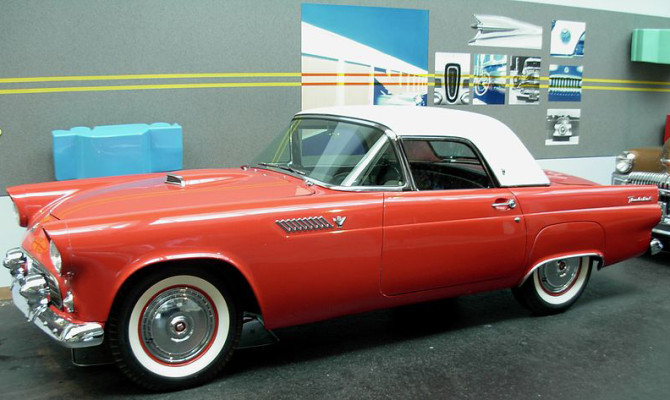
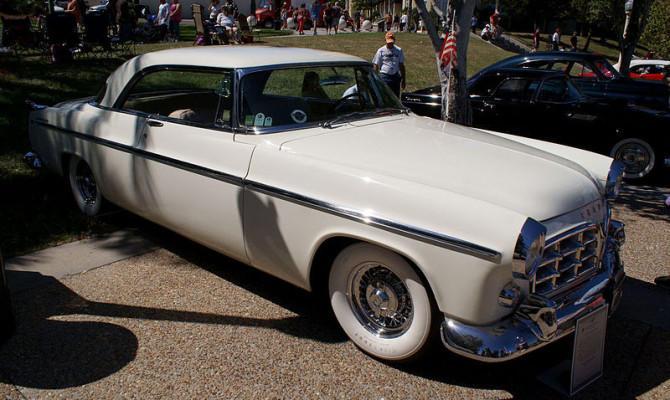
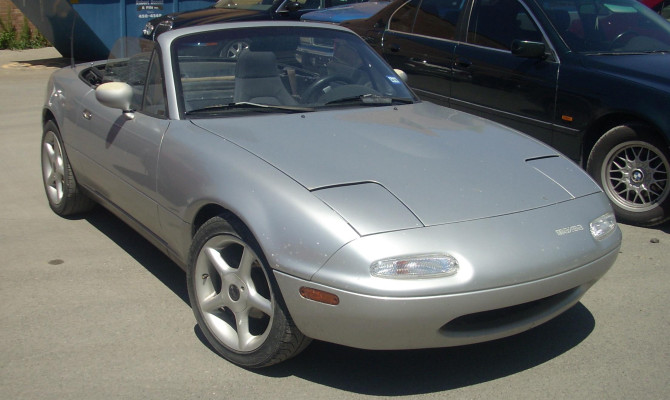
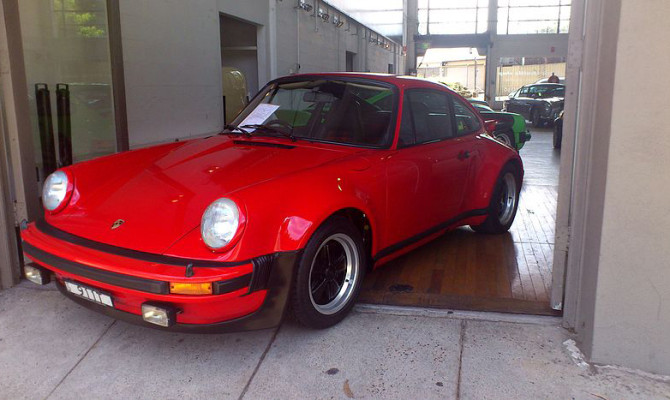
2015 follows 2014 and 2013 as particularly rich years for automotive milestones – here are five automotive anniversaries.
1955 Ford Thunderbird: The Corvette may have been the first post-war American two-seater from one of the Big Three, but it was the Thunderbird that was the most popular. In fact, after a disappointing first two model years, Chevy was considering killing the Corvette until the runaway popularity of the 1955 T-Bird made them reconsider. Made famous in George Lucas’ film, “American Graffiti,” the 1955-57 two-seater “baby birds” remain the most collectible T-Birds. Happy 60th.
1955 Chevrolet Bel Air: The 1955-57 Bel Air is probably the quintessential American collectible car, and it introduced another American milestone — the Chevy small-block V-8. The brainchild of Chevrolet chief engineer Ed Cole, the small block was relatively light, easy to service and expandable — from its original 265 cubic inches up to the ubiquitous 350 and beyond. The Bel Air was just the car to showcase the new overhead-valve V-8.
Mazda Miata: This one makes a lot of us feel old: The Miata is 25. Introduced in late 1989 as a 1990 model, for all intents and purposes, it was a British roadster that wouldn’t leak oil in your garage, or decide not to start below freezing or spontaneously set its dash on fire (not necessarily in that order). Mazda took all the good that we remember from British roadsters (they allegedly dissected several of one of the best, the Lotus Elan) — from sharp handling to a smooth short-throw gearbox — and added five speeds a modern twin-cam engine as well as a beautifully designed manual convertible top. Low mileage first generation Miatas amazingly still trade for under 10 grand in its 25th year; it’s doubtful those prices will hold steady for its 50th.
1955 Chrysler 300: The first of the “letter series” 300s was originally just known as the “300,” although it was succeeded by the 300B, 300C, etc. A gorgeous pillarless coupe that was really only built to go racing in NASCAR, it was powered by a 331-cubic-inch Hemi V-8 and was capable of nearly 130 mph, an amazing figure for the day. Just a few more than 1,700 were built, but it was the inspiration for the sensational sedan introduced by Chrysler in 2005. Happy 60th to the original 300 and happy 10th to the reboot.
1975 Porsche 911 Turbo: The mid-1970s were the dark ages of automotive performance, taking on the moniker “The Malaise Era,” which is known for low compression, emission controls and generally excruciating dullness. The Germans didn’t get that memo and, building on years of racing experience using exhaust-driven turbochargers, Porsche introduced the outlandish 911 Turbo Carrera, otherwise known by the internal project number “930.” Porsche used nearly as crude a setup as the turbo employed by the Corvair a decade earlier, and early 930s were very much an on-off proposition with turbo lag aplenty. But with 0-60 times of around five seconds, the 930 would put most muscle cars to shame. Many owners got caught by surprise by boost coming on while entering a corner — lift off the gas or brake and the rear-engine weight bias plus physics would take care of the rest. A fair number of dentists and pro athletes wrapped 930s around trees. The 40th anniversary has been preceded by a dramatic upswing in 930 prices.
Rob Sass is the vice-president of content for Hagerty Insurance. Hagerty is the world’s leading specialist provider of classic car and boat insurance. Learn more at hagerty.ca.
Most of the time, the automotive world doesn’t serve up a Godfather II, the rare sequel that is the equal or better of the original.
(Sometimes, of course, you get Godfather III.)
Here are the Top 5 cars that today are regarded as classics in their own right, but initially had a hard time living up to the legacy of their predecessors:
1. 1958 Thunderbird
The original two-seater 1955-57 Thunderbirds – or “Baby Birds” – were recognized as classics almost as soon as they went out of production. They were replaced by a larger four-seater that came to be known as “The Square Bird.” While the Square Bird was an immensely popular car that handily outsold its predecessor, the original two-seater remains the one that most people think of when the topic of T-Birds comes up.
2. 1979 Datsun 280ZX
The 280ZX had the misfortune of following one of the all-time greatest classic sports cars, the Datsun 240/260/280Z. And it also committed the cardinal sin in the eyes of sports car enthusiasts (although not necessarily in the eyes of the buying public) of being heavier and more luxurious.
It was derided by the magazines of the time as being a flashy “discomobile” and collectors are only now starting to realize the merits of the comfy and more grownup ZX.
3. 1971 Oldsmobile Toronado
The first generation Toronado that appeared in 1966 was a stylistic and engineering tour de force. Reminiscent of the great classic Cord 810 of 1936, it was a milestone car for GM. Hardly anyone remembers its successor, the second generation Toronado.
Where the ’66 broke the mold, the ’71 was the mold for generic American luxury cars of the 1970s.
4. 1976 Jaguar XJS
This one had the extreme misfortune of replacing one of the most beautiful cars of all time, the Jaguar E-Type. So naturally, people were predisposed to hate it when it came out. Other than initial quality control issues, which have become legendary, the XJS was neither a bad nor ugly car — quite the contrary.
But for Jaguar, lightning just couldn’t strike twice: There was simply no way that the XJS could be as lovely as the E-Type.
5. 1974 Ford Mustang II
The early 1970s were dark times for the automobile. The Arab Oil Embargo of 1973 put the brakes on large displacement high performance engines. What was Ford to do about cars like the Mustang, whose reputation was built on V-8 performance? Replace it with a four-cylinder version based on the Pinto, of course. Although V-6s and V-8s were offered, it was the sting of the anemic four-banger that stuck with the II until Ford replaced it in 1979 with what would become the very good and very popular Fox body Mustang.
Recent Comments
- { Enjoyed your Forest of Bowland in the BMW X5M, particularly the photo of the BMW in front of the main part of Stonyhurst College where... }
- { Bantam designed the Jeep, not Willy's or Ford. The American military gave the original Bantam prototype to Willys and Ford to copy. There is plenty... }
- { All Escalades come with a 6.2-lilter V8 engine that produces 420 horsepower. A six-speed automatic is the only transmission offered and drives the rear wheels.... }
- { Alexandra is an excellent journalist. }
Popular Posts
- Journey to a ‘Sparkling’ Luxury Okanagan Resort “Four lucky readers will put a Dodge Journey’s weekend-...
- The Need For Speed: Hike Those Highway Limits More than half of those polled believe the province sho...
- Drives-U-Crazy… Erratic drivers. An early morning drive from Kelowna to Vancouver is nor...
- Readers Respond: The Pros and Cons of Increasing B.C. Speed Limits Increasing the speed limits will only increase risk to...
- Honda CR-V Review: The Compact Crossover To Get Things Done The CRV is a very stylish and aerodynamic crossover veh...


